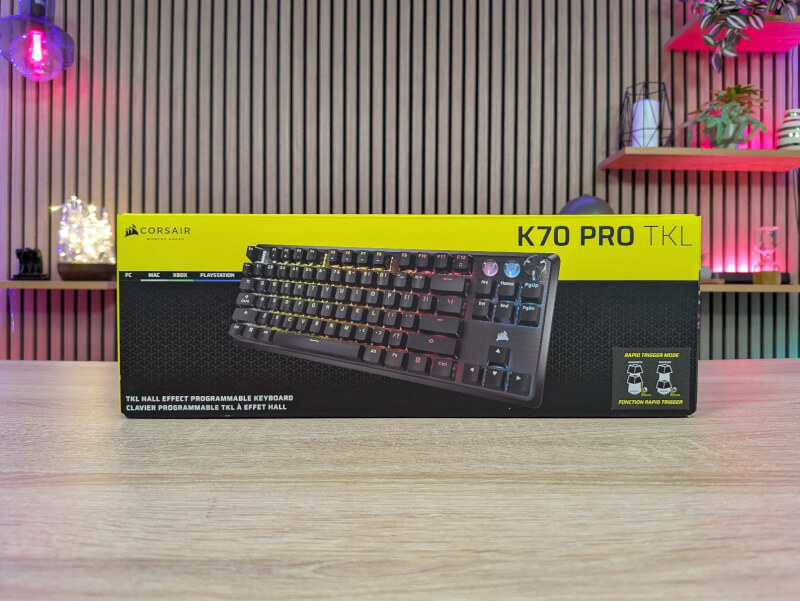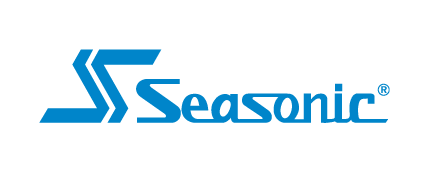Corsair K70 Pro TKL

Central Specifications
- Switches: MGX Hyperdrive magnetic switches
- Keyboard Size: Tenkeyless
- Keyboard Report Rate: Up to 8,000Hz
- On-board Memory: 8MB
- Onboard Profiles : 5
- FlashTap TECHNOLOGY
- Rapid Trigger
A tour around the Corsair K70 Pro TKL
Overall, the Corsair K70 Pro TKL doesn't really stand out in terms of design. It's a pretty standard gaming keyboard in many ways, of course in the TKL size, so without a NUM pad.
There is of course a focus on gaming, which is also the reason for the TKL size.
The K70 Pro TKL stands out, however, in its details, which are subdued but stylish. The keyboard is made of matte black plastic with a brushed aluminum plate under the keys to add a little flair.
There are smaller, but very nice, design details such as rounded corners, subdued branding elements and patterns that help to elevate the impression of the K70 Pro TKL.
The included keycaps on our version are Double-shot ABS with a very comfortable, almost soft-touch surface. Unfortunately, they are quite prone to fingerprints and can quickly end up looking a bit dingy.
Below them are the Corsair MGX Hyperdrive switches, which provide a lot of options for dynamic activation point, Rapid Trigger and much more, which I will go into more detail about in the software and testing section.
The limited form factor means we don't get a full set of dedicated media keys. Instead, some shortcuts are placed as secondary FN functions on the F1 to F8 keys.
There are, however, three dedicated function keys in the top right corner. Here is a key to activate Game Mode. The second is one you can program however you like, but by default is set to play/pause, and then finally there is what Corsair calls a Multi-Functional Rotary Dial.
It is used by default to turn the volume up and down, but can be used for other things via shortcuts. This includes keyboard brightness, horizontal or vertical scrolling, or zoom.
The Corsair K70 Pro TKL also comes with a wrist rest that magnetically snaps onto the bottom of the keyboard. It's soft enough for my preference, with a slightly textured surface featuring the new Corsair graphic pattern.
The inner part of the K70 Pro TKL, which we obviously can’t see ourselves, is provided with two layers of silicone to dampen the sound from the keyboard. There are still distinct clicks when typing, but there are no annoying pings or rattling of any kind. Instead, it’s the classic “clack clack” sound that many people probably like on a “mechanical” keyboard.
The Corsair K70 Pro TKL requires connection via cable and the USB C connector for the included cable is found at the top.
Looking at the bottom of the keyboard, there's not much to see, except that Corsair has also put some effort into the design. There's a single-step height adjustment on the K70 Pro TKL, but otherwise there's nothing else functional to be found here.
Software
Just like with all other Corsair devices, it is through their iCue software that you can customize and update your devices.
Here you have an overview of your connected devices and the option to monitor certain parts of your PC.
Compared to the K70 Pro TKL, there are a lot of customization options. There are the basics like firmware updates and Polling Rate. Here, the K70 Pro TKL has the option of up to 8000 Hz Polling Rate.
There is also, of course, the option for RGB customization. Here, Corsair has some of the most advanced options on the market. You can choose from the predefined options or build your own, with the option of multiple effects stacked in layers.
We can also customize exactly what each key should be used for. It could be program shortcuts, media controls, profile switching, macro functions or integration with Corsair's Voice Mod.
The next step is to customize one of the options that magnetic switches give us, namely the actuation point or even the possibility of multiple actuation points on the same key.
With Corsair's MGX Hyperdrive switches, we have the option to set the actuation point freely between 0.1 mm and 4 mm, which gives a fairly large range.
It is also possible to specify a reset point yourself, i.e. how much the key must be lifted before it can be used again.
It is also possible to create two activation points on each key. This way you can have one function activated at, for example, 1 mm and another at 3.5 mm.
Finally, you can enable Rapid Trigger, which dynamically adjusts the activation. You can specify how sensitive it should be and you have the option to separate the activation and reset values.
Via iCue you can also adjust how much or how little should be deactivated when you turn on Game Mode.
The Game Mode here is a bit more extensive than I've seen on other keyboards. When you enable Game Mode, the K70 Pro TKL goes into an optimized, but also limited, setting.
This means, among other things, that all software control is turned off and things like the Windows key are deactivated. The RGB lighting is also limited to a static color.
You can customize parts of the Game Mode settings yourself, such as specifying what Polling Rate you would like or whether there should be a special Rapid Trigger setting when using Game Mode.
Overall, there are super wide options for customizing the K70 Pro TKL through iCue. It is clear that Corsair has a lot of focus on gaming and features for the demanding gamer. This is seen both in the hardware itself, such as the magnetic switches, but also here in the software with an extensive Game Mode setting and the possibility of very granular customization of the keys.
iCue has worked without any problems throughout my testing. It's been a while since Corsair trimmed iCue down a lot and it has since become a much smaller and more efficient program, as it only downloads elements to the devices that you actually have connected to your system.
Test
I've had the Corsair K70 Pro TKL on my desk for about a week and have used it for a solid mix of both work and gaming.
In terms of general use, I've been super happy with the K70 Pro TKL. I naturally do a lot of typing in connection with my work, and the K70 Pro TKL has been a great companion on the desk.
I usually prefer low-profile keyboards, but the included palm rest for the K70 Pro TKL means it doesn't end up feeling quite as tall as it normally would.
The typing experience is wonderfully responsive with pleasant feedback and for that task I think the 2mm actuation distance that the K70 Pro TKL is set to by default is fine.
I was also very satisfied with the gaming experience. The many customization options mean that you can tune the K70 pro TKL exactly as you want.
As I've mentioned in other reviews of Hall Effect keyboards, my general skill level is not so high that dynamic actuation distances and Rapid Trigger options mean that I'm automatically at the top of the winner's list.
After all, these kinds of features are moving by too small margins. However, I felt that the Corsair K70 Pro TKL was a fantastic tool for the task, and gave me some of the best conditions to do my best.
So even though I haven't become a Call of Duty champ over the past week, my time with the K70 Pro TKL has made me want to play FPS games again a lot more than I have in a long time.
It's of course very much a matter of personal preference how you prefer your keyboard set up. For example, I couldn't function at all with super low actuation distances on my keys.
The K70 Pro TKL can be adjusted with actuation distance down to 0.1 mm, but already around 1 mm it became too sensitive for my fingers.
Similarly, I couldn't get the ability to have two functions on the same key at different distances to work in practice. I can't move my fingers precisely and steadily enough for it to make sense to me. I tend to almost always press all the way down on my keystrokes.
However, I can't complain about having the option. I have no doubt that there are people who can easily benefit from it, and when that is the case, there are super good options with the K70 Pro TKL.
If you want the latest features out of your keyboard, the Corsair K70 Pro TKL is a great choice. One of the features that is also included is FlashTap. With FlashTap you can make your movements even faster than with just Rapid Trigger.
Normally, when you provide opposing inputs for movement, for example pressing both the right and left buttons when strafing in an FPS game like Call of Duty, you will not move as the opposing inputs conflict.
With FlashTap, the last input will always be prioritized, regardless of whether other keys are pressed. This means you can strike even faster.
It's a feature that must be activated via a keyboard shortcut, but can be combined with Rapid Trigger to optimize things even more.
However, you should be aware that in some games it is considered cheating. For example, in CS:GO, FlashTap and similar “input-automation features” are not allowed. So remember to make sure that it is not activated if you play CS:GO.
Price
At the time of writing, I can find the Corsair K70 Pro TKL with an online price of just under 200$. That places it right next to other similar options, such as the Logitech Pro X TKL Rapid, which we almost just reviewed.
Conclusion
I've really enjoyed my time with the Corsair K70 Pro TKL. It's a well-built and stylish TKL keyboard, packed with the latest gaming features and made with great materials.
The many features and customization options haven't made me a much better gamer overnight. However, it has made me a happy gamer, as the K70 Pro TKL is super comfortable to use and is a great experience to use, for both work and gaming.
However, you should consider whether features like Hall Effect contacts are really worth it. Because the price is on the high end, and as I said, it probably only really benefits high-end players in a real way.
We end up with a final score of 9 for a super well-made keyboard. It's right in front of alternatives like the Logitech Pro X TKL Rapid, as we get a few more features and wrist rest for the same price.
Advantages:
- Good build quality and materials
- Included wrist rest
- Solid software
- Rapid trigger and FlashTap options
Disadvantages:
- Nothing noteworthy

Latest keyboard
-
27 Febkeyboard
-
18 Febkeyboard
Logitech Pro X TKL Rapid
-
02 Deckeyboard
Glorious GMMK 3 Pro HE
-
12 Novkeyboard
Glorious GMMK 3 HE
-
05 Novkeyboard
Logitech POP Icon Combo
-
01 Novkeyboard
Corsair introduces the K70 PRO TKL
-
24 Octkeyboard
Logitech G915 X Lightspeed TKL
-
21 Octkeyboard
ASUS ROG Falchion Ace HFX
Most read keyboard
Latest keyboard
-
27 Febkeyboard
Corsair K70 Pro TKL
-
18 Febkeyboard
Logitech Pro X TKL Rapid
-
02 Deckeyboard
Glorious GMMK 3 Pro HE
-
12 Novkeyboard
Glorious GMMK 3 HE
-
05 Novkeyboard
Logitech POP Icon Combo
-
01 Novkeyboard
Corsair introduces the K70 PRO TKL
-
24 Octkeyboard
Logitech G915 X Lightspeed TKL
-
21 Octkeyboard
ASUS ROG Falchion Ace HFX






